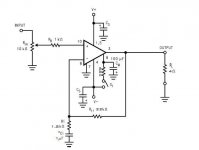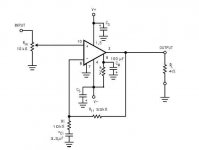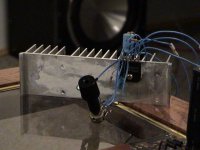I have built my first chip amp today. I used the lm3886 chip. It worked fine, but I noticed that when I turned it up all the way, the speaker moved out a little. That means that I was getting dc on the output. Does anybody know what could be causing that? One more question: what's the smallest feedback resistor that I can use to maximize gain without the amp oscillating?
I was playing around with it so much, that I ended up frying the chip. Oh well....I have 4 more, and my next project is to parallel all 4 of them to drive a pair of subs.
I was playing around with it so much, that I ended up frying the chip. Oh well....I have 4 more, and my next project is to parallel all 4 of them to drive a pair of subs.
Attachments
carlosfm said:68ohms from the mute pin to V-?

1uf from Ri to ground?


68 Ohms as per datasheet for the 0.5 mA.
1 uF for the HP at 88 Hz which might seem a bit high depending on what the initial test is for.
Urban, how about multiply the 68 ohms with 1000? 68 kohms!UrSv said:
68 Ohms as per datasheet for the 0.5 mA.
1 uF for the HP at 88 Hz which might seem a bit high depending on what the initial test is for.
peranders said:
Urban, how about multiply the 68 ohms with 1000? 68 kohms!
That would probably be more accurate by a factor of 1000...
Seing is sometimes as subjective as hearing I think...
68 Ohms and DC.
I hate to admit this, but once I used a 58 ohm resistor and it worked... but that was because of a brief mental lapse (not my last), since I've switched to 18K like Jax.
More on topic, how much DC offset is acceptable? I get .02 V DC at the output (and my speaker grills are not removable for a visual check). Is this ok?
I hate to admit this, but once I used a 58 ohm resistor and it worked... but that was because of a brief mental lapse (not my last), since I've switched to 18K like Jax.
More on topic, how much DC offset is acceptable? I get .02 V DC at the output (and my speaker grills are not removable for a visual check). Is this ok?
<50mV is usually OK with most normal woofers. Purists want 0 always, though.
The offset varies a little with temperature so even if you balance it out with the + to ground resistor it will seldom be stable. You could add a DC bias servo but in my opinion those cause more harm than good.
The offset varies a little with temperature so even if you balance it out with the + to ground resistor it will seldom be stable. You could add a DC bias servo but in my opinion those cause more harm than good.
DC on the output, which varies with the volume control means that there is DC on the input. Insert a capacitor between the input and the 10 kOhm volume pot. This will create a high pass filter, which of course blocks DC. In order for it to also not roll off the bass, make sure to use a high enough cap. Make it 10 uF or more.... I noticed that when I turned it up all the way, the speaker moved out a little. That means that I was getting dc on the output. Does anybody know what could be causing that?
You increase gain by increasing (not decreasing) the feedback resistor. Do not reduce gain to less than 10. Since the Gain-Bandwidth product of the 3886 is quite low (3 MHz), do not go over a gain of about 50 or so. If you increase gain to 100 or more, you will notice high-frequency rolloff. You will also get more noise (hiss) at the output with higher gain, so don't go crazy. If you need a gain of over 50, then you would get better sound quality by using a pre-amp stage consisting of a high quality audio op-amp or even discretes if you up to the task. Determine the proper gain by finding the ratio of your power supply voltage, and the peak voltage of the input source (e.g. line level is nominally 0.7 Vrms, which is 2 volts peak to peak, or +-1 V, so if your power supply is +-25V, you need a gain of 25 to ensure that the amp will deliver its full power when you crank the volume.).what's the smallest feedback resistor that I can use to maximize gain without the amp oscillating?
Like I said before, I ended up frying the chip. I'll have another amp built in a couple of days, because I don't have time to do it now. The last amp was running off a 35 0 35 transformer, but the voltage after the caps was +-50. I know that the voltage was a little high, but it worked. I measured the output, and it was only putting out 4v to the speaker. So to increase the output voltage, I have to increasing gain, or do I have to use a preamp?
Don't do it.
aahhhhhhh.... I'm no genious but I just read your threads, if you start building stuff I think you are going to hurt yourself. Especially if you make that 4 kW car amp you are talking about. Please please please read the data sheets for the chip amp, and about 10 web sites that tell one how to build it before going further, and a book on opamps would be good too.
aahhhhhhh.... I'm no genious but I just read your threads, if you start building stuff I think you are going to hurt yourself. Especially if you make that 4 kW car amp you are talking about. Please please please read the data sheets for the chip amp, and about 10 web sites that tell one how to build it before going further, and a book on opamps would be good too.
Thats why ur chip fried.
The ABSOLUTE MAX voltage is 84V
Putting 100V into surely is the cause of the dead chip.
The LM3886 shouldn't just fry. I have really tested my 3886 amp. I use it for a sub, and I can't even count how many times it has been taken out.
And i cant even count how many times i turned it above how loud it shoudl go. as i said, it was for a sub, so it can be hard to hear clipping.
Reduce the voltage, and you won't fry the chip
just out of curiosity, how did you design yours? P2P, or PCB?
-Mike
The ABSOLUTE MAX voltage is 84V
Putting 100V into surely is the cause of the dead chip.
The LM3886 shouldn't just fry. I have really tested my 3886 amp. I use it for a sub, and I can't even count how many times it has been taken out.
And i cant even count how many times i turned it above how loud it shoudl go. as i said, it was for a sub, so it can be hard to hear clipping.
Reduce the voltage, and you won't fry the chip
just out of curiosity, how did you design yours? P2P, or PCB?
-Mike
soundNERD said:
The ABSOLUTE MAX voltage is 84V
Putting 100V into surely is the cause of the dead chip.
The LM3886 shouldn't just fry. I have really tested my 3886 amp. I use it for a sub, and I can't even count how many times it has been taken out.
And i cant even count how many times i turned it above how loud it shoudl go. as i said, it was for a sub, so it can be hard to hear clipping.
Reduce the voltage, and you won't fry the chip
just out of curiosity, how did you design yours? P2P, or PCB?
-Mike
I just built another lm3886 and im running it off the same +-50v power supply. I have the chip on a heatsink, just like last time, but now I used the heat transfer paste stuff. Everything is wired P2P. I have the chip running for about 10-15 mins, and the heatsink is a little warm. I think that the last one fried because it got too hot. The protection circuitry was shutting the amp off pretty frequently, so it was running at over 100 deg. C. Oh well...still have 4 more.
BTW, could you post the schematic of your amp?
I want to use my amp for a sub too, but it only puts out 2v...
Attachments
you're pretty stubborn! 
the datasheet tells you the absolute maximum voltage is 84v (thus, +/- 42 volts and YES, this matters, a lot). Either go on frying chips or use a psu with a lower voltage.
the by many people preferred (or agreed upon) schematics are found all around this forum. One good thread to start is this one (greg's ultimate gainclone) and a *very* good site to get started on building gainclones is nuuk's site . start by reading the basic gainclone pages. For a non iverting schematic check this post by peter daniel.
btw, i dont see any supply caps at the chip. very much needed (especially when building a sub amp!)
but seriusly dudu, lower that psu voltage ...

the datasheet tells you the absolute maximum voltage is 84v (thus, +/- 42 volts and YES, this matters, a lot). Either go on frying chips or use a psu with a lower voltage.
the by many people preferred (or agreed upon) schematics are found all around this forum. One good thread to start is this one (greg's ultimate gainclone) and a *very* good site to get started on building gainclones is nuuk's site . start by reading the basic gainclone pages. For a non iverting schematic check this post by peter daniel.
btw, i dont see any supply caps at the chip. very much needed (especially when building a sub amp!)
but seriusly dudu, lower that psu voltage ...

- Status
- This old topic is closed. If you want to reopen this topic, contact a moderator using the "Report Post" button.
- Home
- Amplifiers
- Chip Amps
- lm3886-dc on the output



